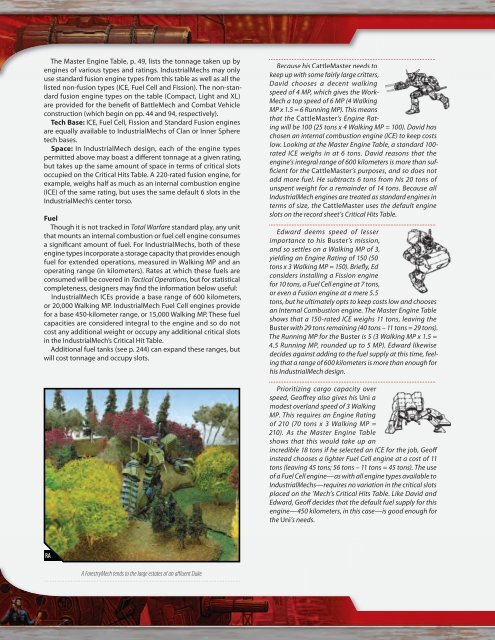the shape of things to come
the shape of things to come
the shape of things to come
Create successful ePaper yourself
Turn your PDF publications into a flip-book with our unique Google optimized e-Paper software.
The Master Engine Table, p. 49, lists <strong>the</strong> <strong>to</strong>nnage taken up by<br />
engines <strong>of</strong> various types and ratings. IndustrialMechs may only<br />
use standard fusion engine types from this table as well as all <strong>the</strong><br />
listed non-fusion types (ICE, Fuel Cell and Fission). The non-standard<br />
fusion engine types on <strong>the</strong> table (Compact, Light and XL)<br />
are provided for <strong>the</strong> benefi t <strong>of</strong> BattleMech and Combat Vehicle<br />
construction (which begin on pp. 44 and 94, respectively).<br />
Tech Base: ICE, Fuel Cell, Fission and Standard Fusion engines<br />
are equally available <strong>to</strong> IndustrialMechs <strong>of</strong> Clan or Inner Sphere<br />
tech bases.<br />
Space: In IndustrialMech design, each <strong>of</strong> <strong>the</strong> engine types<br />
permitted above may boast a diff erent <strong>to</strong>nnage at a given rating,<br />
but takes up <strong>the</strong> same amount <strong>of</strong> space in terms <strong>of</strong> critical slots<br />
occupied on <strong>the</strong> Critical Hits Table. A 220-rated fusion engine, for<br />
example, weighs half as much as an internal combustion engine<br />
(ICE) <strong>of</strong> <strong>the</strong> same rating, but uses <strong>the</strong> same default 6 slots in <strong>the</strong><br />
IndustrialMech’s center <strong>to</strong>rso.<br />
Fuel<br />
Though it is not tracked in Total Warfare standard play, any unit<br />
that mounts an internal combustion or fuel cell engine consumes<br />
a signifi cant amount <strong>of</strong> fuel. For IndustrialMechs, both <strong>of</strong> <strong>the</strong>se<br />
engine types incorporate a s<strong>to</strong>rage capacity that provides enough<br />
fuel for extended operations, measured in Walking MP and an<br />
operating range (in kilometers). Rates at which <strong>the</strong>se fuels are<br />
consumed will be covered in Tactical Operations, but for statistical<br />
completeness, designers may fi nd <strong>the</strong> information below useful:<br />
IndustrialMech ICEs provide a base range <strong>of</strong> 600 kilometers,<br />
or 20,000 Walking MP. IndustrialMech Fuel Cell engines provide<br />
for a base 450-kilometer range, or 15,000 Walking MP. These fuel<br />
capacities are considered integral <strong>to</strong> <strong>the</strong> engine and so do not<br />
cost any additional weight or occupy any additional critical slots<br />
in <strong>the</strong> IndustrialMech’s Critical Hit Table.<br />
Additional fuel tanks (see p. 244) can expand <strong>the</strong>se ranges, but<br />
will cost <strong>to</strong>nnage and occupy slots.<br />
RA<br />
A ForestryMech tends <strong>to</strong> <strong>the</strong> large estates <strong>of</strong> an affl uent Duke.<br />
Because his CattleMaster needs <strong>to</strong><br />
keep up with some fairly large critters,<br />
David chooses a decent walking<br />
speed <strong>of</strong> 4 MP, which gives <strong>the</strong> Work-<br />
Mech a <strong>to</strong>p speed <strong>of</strong> 6 MP (4 Walking<br />
MP x 1.5 = 6 Running MP). This means<br />
that <strong>the</strong> CattleMaster’s Engine Rating<br />
will be 100 (25 <strong>to</strong>ns x 4 Walking MP = 100). David has<br />
chosen an internal combustion engine (ICE) <strong>to</strong> keep costs<br />
low. Looking at <strong>the</strong> Master Engine Table, a standard 100rated<br />
ICE weighs in at 6 <strong>to</strong>ns. David reasons that <strong>the</strong><br />
engine’s integral range <strong>of</strong> 600 kilometers is more than suffi<br />
cient for <strong>the</strong> CattleMaster’s purposes, and so does not<br />
add more fuel. He subtracts 6 <strong>to</strong>ns from his 20 <strong>to</strong>ns <strong>of</strong><br />
unspent weight for a remainder <strong>of</strong> 14 <strong>to</strong>ns. Because all<br />
IndustrialMech engines are treated as standard engines in<br />
terms <strong>of</strong> size, <strong>the</strong> CattleMaster uses <strong>the</strong> default engine<br />
slots on <strong>the</strong> record sheet’s Critical Hits Table.<br />
Edward deems speed <strong>of</strong> lesser<br />
importance <strong>to</strong> his Buster’s mission,<br />
and so settles on a Walking MP <strong>of</strong> 3,<br />
yielding an Engine Rating <strong>of</strong> 150 (50<br />
<strong>to</strong>ns x 3 Walking MP = 150). Briefl y, Ed<br />
considers installing a Fission engine<br />
for 10 <strong>to</strong>ns, a Fuel Cell engine at 7 <strong>to</strong>ns,<br />
or even a Fusion engine at a mere 5.5<br />
<strong>to</strong>ns, but he ultimately opts <strong>to</strong> keep costs low and chooses<br />
an Internal Combustion engine. The Master Engine Table<br />
shows that a 150-rated ICE weighs 11 <strong>to</strong>ns, leaving <strong>the</strong><br />
Buster with 29 <strong>to</strong>ns remaining (40 <strong>to</strong>ns – 11 <strong>to</strong>ns = 29 <strong>to</strong>ns).<br />
The Running MP for <strong>the</strong> Buster is 5 (3 Walking MP x 1.5 =<br />
4.5 Running MP, rounded up <strong>to</strong> 5 MP). Edward likewise<br />
decides against adding <strong>to</strong> <strong>the</strong> fuel supply at this time, feeling<br />
that a range <strong>of</strong> 600 kilometers is more than enough for<br />
his IndustrialMech design.<br />
Prioritizing cargo capacity over<br />
speed, Ge<strong>of</strong>f rey also gives his Uni a<br />
modest overland speed <strong>of</strong> 3 Walking<br />
MP. This requires an Engine Rating<br />
<strong>of</strong> 210 (70 <strong>to</strong>ns x 3 Walking MP =<br />
210). As <strong>the</strong> Master Engine Table<br />
shows that this would take up an<br />
incredible 18 <strong>to</strong>ns if he selected an ICE for <strong>the</strong> job, Ge<strong>of</strong>f<br />
instead chooses a lighter Fuel Cell engine at a cost <strong>of</strong> 11<br />
<strong>to</strong>ns (leaving 45 <strong>to</strong>ns; 56 <strong>to</strong>ns – 11 <strong>to</strong>ns = 45 <strong>to</strong>ns). The use<br />
<strong>of</strong> a Fuel Cell engine—as with all engine types available <strong>to</strong><br />
IndustrialMechs—requires no variation in <strong>the</strong> critical slots<br />
placed on <strong>the</strong> ’Mech’s Critical Hits Table. Like David and<br />
Edward, Ge<strong>of</strong>f decides that <strong>the</strong> default fuel supply for this<br />
engine—450 kilometers, in this case—is good enough for<br />
<strong>the</strong> Uni’s needs.


